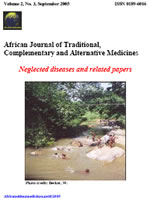
|
African Journal of Traditional, Complementary and Alternative Medicines
African Ethnomedicines Network
ISSN: 0189-6016
Vol. 13, No. 6, 2016, pp. 179-185
|
 Bioline Code: tc16158
Bioline Code: tc16158
Full paper language: English
Document type: Research Article
Document available free of charge
|
|
|
African Journal of Traditional, Complementary and Alternative Medicines, Vol. 13, No. 6, 2016, pp. 179-185
| en |
PHYTOCHEMICAL SCREENING, ANTI-INFLAMMATORY AND ANALGESIC PROPERTIES OF PENTANISIA PRUNELLOIDES  FROM THE EASTERN CAPE PROVINCE, SOUTH AFRICA FROM THE EASTERN CAPE PROVINCE, SOUTH AFRICA
Mathews, Miya Gugulethu; Ajayi, Oyemitan Idris; Opeoluwa, Oyedeji Oyehan; Oluwatobi, Oluwafemi Samuel; Benedicta N., Nkeh-Chungag; Phindile, Songca Sandile & Omowumi, Oyedeji Adebola
Abstract
Background Pentanisia prunelloides is a medicinal plant widely used to remedy various ailments including infections, fever and
rheumatism in Eastern Cape Province of South Africa. There is scanty report on the phytochemical and biological properties of the
plant; hence various solvent extracts of the dried plant materials were phytochemically screened, and its aqueous extract evaluated
for acute toxicity effect, analgesic and antiinflammatory properties in rodents.
Methods and Materials: Different extracts of both leaf and rhizome were obtained separately with ethanol, methanol and water.
Portions of the filtrate were used for qualitative screening of secondary metabolites and remaining portions were concentrated and
dried. Dried grounded leaf and rhizome of the plant were also used for quantitative screening for some major components. The
aqueous extract of the leaf and rhizome were used for acute toxicity (LD50) test, antiinflammatory and analgesic activities in rodents.
Results: The qualitative phytochemical screening showed the presence of several phytoconstituents with saponins, flavonoids and
alkaloids constituting highest constituents in the leaf and rhizome. The LD50 of the aqueous extracts (from leaf or rhizome) was
found to be ≥5000 mg/kg orally. The leaf and rhizome aqueous extract (250-500 mg/kg) significantly (p<0.01) reduced egg albumininduced
paw oedema and paw licking in mice induced by formalin, signifying antinociceptive and antiinflammatory activities
respectively.
Conclusion It is concluded that the leaf and rhizome of P. prunelloides are rich in various phytochemicals which could be associated
with their medicinal uses. The aqueous leaf and rhizome extracts are similarly non-toxic orally, showed antiinflammatory and
analgesic potentials thus rationalizing its use in folkloric medicine.
Keywords
Rubiaceae; secondary metabolites; oral acute toxicity; analgesic; anti-inflammatory
|
| |
© Copyright 2016 - African Journal of Traditional, Complementary and Alternative Medicines
Alternative site location: http://journals.sfu.ca/africanem/index.php/ajtcam
|
|
